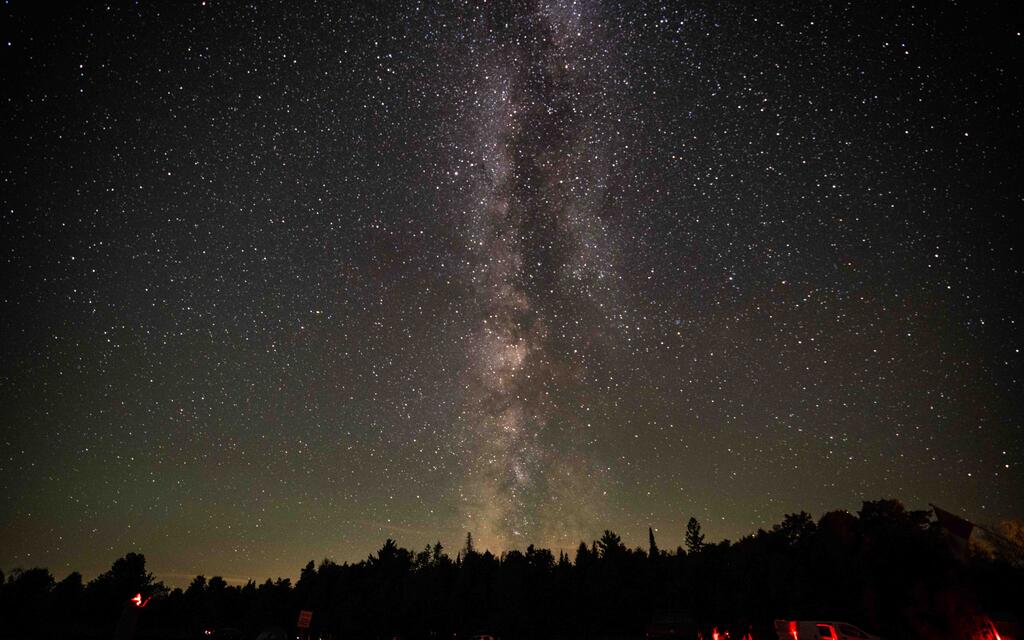While many of us are tucked up in cozy comfort in the night hours, the intrepid astronomers among us head outdoors to drink in the starry night skies.
In winter the cold air holds less moisture than warm air so the night sky is amazingly clear; plus, this is the time of year when some amazing astronomical events take place. This year we have some epic stargazing conditions to take in, and for most you won’t need a telescope to do it.
Bundle up against the cold with a thermos full of coffee at your side and settle into a prime stargazing location with your head tipped back to drink in the millions of stars overhead.
See the Darkest Skies
Choose from two dark sky preserves in Ontario’s Highlands. Bring a thermos of something to keep you warm, a lawn chair, blanket, and telescope or camera if you have one. If not you can enjoy the show just by tipping back your head and drinking in the night sky.
North Frontenac Astronomy Park: This preserve is located south of Plevna and is known for its phenomenally dark skies set amongst the rugged Canadian shield of North Frontenac. There is an on-site parking area washrooms, and a concrete pad where you can set up a telescope (or a lawn chair).
Lennox & Addington Dark Sky Viewing Area: The Dark Sky Viewing Area is just south of Bon Echo Provincial Park, a location with some of the darkest skies in Ontario and a viewing experience similar to that which was available more than 100 years ago. The Viewing Area had some improvements made over the past year, that includes an expanded concrete platform and solar power for telescope and power equipment. They host many astronomy events each year.
Leonid Meteor Shower (Nov. 3 to Dec. 2, 2025)
Between Nov. 3 and Dec. 2, the Leonid Meteor Shower will pass by Earth, peaking on the night of Nov. 16 to 17. The best time to catch this celestial event is after midnight and into the early morning hours, when the sky is darkest and the meteors are most active.
While the Leonids aren’t the most intense shower of the year, you can still expect to see up to 15 meteors per hour streaking across the sky. The shower will be visible to the naked eye under clear, dark skies, with minimal interference from the moon, making this a great year for viewing.
New Moon (Nov. 20 and Dec. 19, 2025)
Both November 20 and December 19 mark new moons, when the sky goes completely dark—no moonlight to outshine the stars. This is prime time for stargazing, spotting faint constellations, or catching late-season meteors like the Leonids or Ursids. With a clear sky and a dark viewing area, you’ll get a crystal-clear look at the night sky’s deeper details. What you’ll see in 30 minutes under a new moon sky is next-level.
Geminid Meteor Shower (Dec. 1 to Dec. 21, 2025)
Between Dec. 1 to Dec. 21 one of the largest meteor showers of the year will pass by Earth that will peak on Dec. 12 to 13. The best time to view the meteor shower, according to NASA, will be on one of these two days between 10:30 p.m. and 2 a.m.
Watch as more than 120 meteors per hour streak past our planet in this phenomenal astronomical event. The Geminid Meteor Shower will be visible by the naked eye but feel free to pull out the binoculars or telescope if you have any.
To take in the show, visit a dark sky viewing area or another location away from city lights and lie down with your feet pointing south, then wait for the shooting star show to begin.
Winter Solstice (Dec. 21, 2025)
The winter solstice arrives on Dec. 21,, marking the shortest day and longest night of the year in Ontario. It’s a turning point because after this, the days slowly begin to grow longer again. For skywatchers, it’s a great night to lean into the early darkness and soak in the quiet of the season.
With the moon in a waning phase and long hours of uninterrupted night, it's an ideal time to stargaze, reflect, or even spot late-year meteors like the Ursids (which peak just after, around Dec 22–23). Whether you’re watching the stars or lighting a fire to welcome back the sun, the solstice is a beautiful pause in the rush of the season.
Ursid Meteor Shower (Dec. 21 to 22, 2025)
Just after the winter solstice, the Ursid Meteor Shower will peak on the night of Dec. 21 into the early hours of Dec. 22, and this year’s viewing conditions are ideal thanks to a perfectly timed new moon.
The Ursids aren’t the flashiest shower of the year, with typical rates of around 5 to 10 meteors per hour, but what they lack in volume they make up for in timing and charm. With long, dark winter nights and a radiant high in the northern sky (near the Little Dipper), you’ve got hours of uninterrupted skywatching ahead. The Ursids have been known to produce surprise bursts of activity, making a quiet night under the stars potentially unforgettable.
Aurora Borealis
If your first thought was the northern lights can’t be seen south of northern Ontario, you’d be wrong. The famed Aurora Borealis is at times visible in more southerly locations as well, and this year is one of those times.
As with other astronomical happenings, winter is the best time to see the northern lights. In 2025, the lights are expected to reach southern parts of Ontario during the month of December and various points in January and February. Visit the Geophysical Institute’s website for a forecast of when and where the best aurora will be found.




